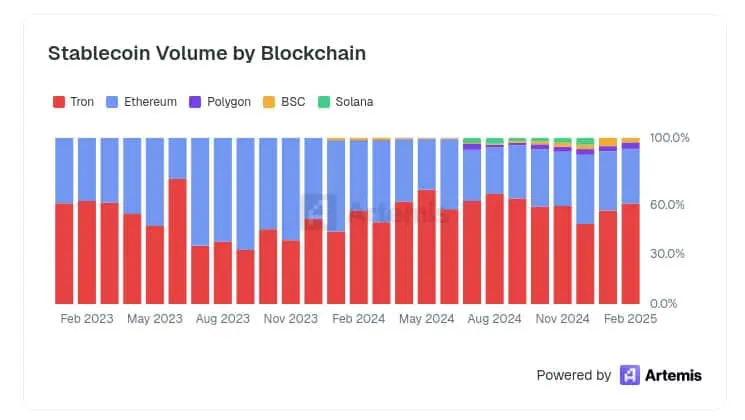
The use of stablecoins in business-to-business (B2B) payments is exploding, driving new dynamics in international trade and revealing unexpected patterns in blockchain selection.
A recent report published by Artemis, a cryptocurrency and stablecoin analytics platform, has revealed how stablecoins on the TRON blockchain are making a difference in business payments, with unprecedented year-over-year growth of 288%.
Most striking is the report's revelation that the influence of these digital currencies on payments and business commerce is not limited to emerging markets in Africa, Asia, and Latin America, but is also spreading strongly to the United States and Europe. For experts, this phenomenon raises fascinating questions about the forces driving this adoption, the players behind the transactions, and how these technologies are reshaping the global landscape of crypto transactions.
TRADE WITH THE MAIN STABLECOINS HEREThe accelerated growth of B2B payments with stablecoins in the last year
The use of stablecoins for business-to-business (B2B) payments has seen notable growth in the last year, according to the report The firm's data. Based on data from 31 companies that process stablecoin payments, the annualized stablecoin payment volume reached approximately $72.300 billion in February 2025.

Source: Artemis
Within this panorama, B2B payments account for the majority of the volume, with an annualized rate close to $36.000 billion, far outpacing other types of transactions such as person-to-person (P2P) transfers or card payments linked to stablecoins. Artemis data reflects an increasingly strong adoption of stablecoins as an efficient and reliable tool for settle business payments in a digital and globalized environment.
The report highlights that the majority of these settlements are carried out directly on blockchains, taking advantage of the speed and transparency offered by these technologies. Furthermore, the diversity of blockchains used, including Ethereum, TRON, and Polygon, facilitates broad interoperability and competitive costs, key aspects for driving the use of stablecoins in corporate payments.
Thus, although the stablecoin market continues to expand and evolve, these data show that stablecoins are gaining ground as a viable alternative for business payments, contributing to the digitalization and efficiency of B2B transactions globally.
Use your crypto anywhere you want – Bit2Me CardTRON leads the stablecoin market in B2B payments
One of Artemis' most surprising findings is TRON's dominance in stablecoin transactions outside of the purely crypto space. Traditionally, TRON has been known for its strong presence in emerging markets such as Africa, Asia, and Latin America. However, the report reveals that TRON also dominates payments originating in the United States and Europe, shattering the notion that its influence is limited to developing regions.
TRON's strength lies in its robust and efficient technology: its virtual machine compatible with Solidity (TVM) allows the development of smart contracts and tokens under standards TRC-20 y TRC-721, similar to Ethereum. In addition, its algorithm Delegated Proof of Stake (DPoS) It offers high speed and reduced costs, key factors in facilitating fast and economical payments in everyday commerce.
Thanks to these advantages, TRON facilitates the rapid and low-cost movement of stablecoins like USDT, boosting its use in real-world payments ranging from remittances to e-commerce. The Artemis report highlights that TRON accounts for approximately 60% of stablecoin transaction volume, followed by Ethereum, Polygon, and BNB Chain. Notably, the average B2B transaction size on TRON and Ethereum exceeds $219.000, far higher than other blockchains, underscoring the preference of large enterprises for these networks for large payments.

Source: Artemis
The decisive factors in choosing stablecoins and blockchains
While one might initially think that choosing a blockchain for stablecoin payments is based solely on the user's or company's country of origin, the Artemis report shows that the reality is much more complex. One relevant factor is payment corridors—the platforms and services that facilitate the transfer and settlement of funds between different blockchains and fiat currencies.
These brokers have a preference for certain networks and coins due to liquidity, reliability, and operating costs. This dynamic significantly influences which stablecoins and blockchains ultimately dominate in the real world.
Furthermore, preference for the final destination of the transaction has a significant impact. Companies tend to choose blockchains that are compatible and efficient with the destination platforms, thus encouraging payment concentrations in ecosystems with greater acceptance and functionality. This partly explains why TRON, despite not having the global coverage of Ethereum, has managed to position itself as a leader in key regions and grow in Western markets.

Main Cryptocurrencies Course
Basic levelBit2Me Academy brings you a new course in which you will learn everything you need about the most important cryptocurrencies that exist today.
Revolutionizing B2B payments into a new digital era
The consolidation of stablecoins and the TRON blockchain in B2B payments marks a new era in the way businesses transact. This isn't just about technological adoption, but a structural shift that redefines the speed, cost, reach, and trust of crypto transactions.
Stablecoins are becoming a crucial bridge for global trade, facilitating cross-border payments, reducing friction associated with traditional fiat currencies, and opening up opportunities for underserved markets.
The 288% year-over-year growth in business payments using these digital assets reflects the impact they're already having and will have as blockchains continue to innovate in efficiency and security.
Prepare your wallet and explore the potential of the cryptocurrency world.In short, the report published by Artemis not only confirms the predominant role of stablecoins and TRON in the current landscape of business commerce, but also opens the door to reflection on the future of these payments, where efficiency, scalability, and trust will be the foundation for continued growth. In this sense, stablecoins are not just a financial product; they are the silent engine driving the mass and efficient adoption of the decentralized digital economy.
Investing in cryptoassets is not fully regulated, may not be suitable for retail investors due to high volatility and there is a risk of losing all invested amounts.


